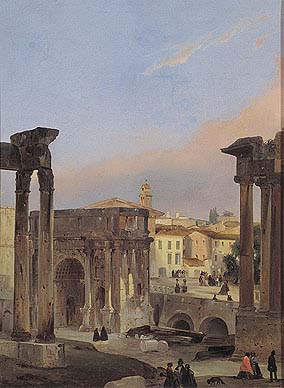06.08.2006 14:47
 2 June 2006 - 3 September 2006
2 June 2006 - 3 September 2006
The exhibition in the General Staff building presents more than 100 works by Ippolito Caffi (1809-1866), one of the best known masters of the Venetian Veduta (urban landscape).
The exhibition was organized by the State Hermitage together with the Administration of Rome with the cooperation of the Ministry of Culture and Artistic Heritage of the Italian Republic and the Ministry of Higher Education and Science of the Italian Republic with support from the General Consulate of the Italian Republic in St. Petersburg.
Ippolito Caffi was one of the most widely appreciated artists of his time, a restless individual who was an indefatigable and curious traveler and a sincere patriot. The artist was born in the small city of Belluno, in the northern part of the Veneto region. He studied in the Venetian Academy of Arts. Having decided to devote himself to landscape painting, Caffi learned a great deal in Venice, which had a centuries old tradition of urban landscape that was developed in the 18th century by outstanding masters from Canaletto to Bellotto and Guardi.
After completing his course of studies at the Venetian Academy, he settled in Rome, where he was caught up in the city's stormy artistic life pursued by the multinational colony of artists working in various genres. Moreover, the artist was drawn into the very vortex of political and revolutionary events. He became an active participant in the Risorgimento, the movement to drive out the Austrians and unify Italy. .
Caffi was long considered the last important representative of the “Veduta” and a direct heir to Canaletto. However, he was fully a man of the 19th century and belonged to a new breed of artist. At this time photography appeared on the scene and entered into competition with the painting of landscapes and views. Dry topographical accuracy which was inherent in the painting of imitators of Canaletto no longer satisfied the artist, who had a fervent imagination and thirst for impressions. .
Ippolito Caffi saw his calling as a chronicler of history as it was developing before his eyes. His thirst to see everything and capture it on canvas or paper prompted Caffi to pursue many unusual ventures. For example, he took off with the French air navigator Francisque Arban in a hot air balloon on a flight over Rome. The balloon flew at an elevation of up to 3,000 meters and was carried a distance of 12 km. Previously unseen vistas opened before the artist and he saw the Eternal City as no other painter had seen it before. The panoramas captured by Caffi from a height that was unimaginable at the time are also shown in this exhibition.
We can follow the artist on an imaginary journey through many cities of Europe, the Near and Middle East. Besides Rome and Venice, there are Naples, Genoa, Turin, Nice, Geneva, Paris, Athens, Istanbul, Jerusalem and Cairo.
As a reporter-artist, Caffi favored unusual landscapes and new perspectives: many sites well known to the modern spectator are presented from an unexpected angle in his works. One can see, for example, Venice in winter, with the snow-covered cupola of the Salute Church. To a Venetian critic of the time, this seemed more reminiscent of Petersburg in winter than of Venice. In one of his letters Caffi even spoke of his intention to take a long trip to Russia's northern capital, though this wish was in fact never implemented.
In his last journey, Ippolito Caffi sailed aboard the naval vessel Re d'Italia in order to witness and record a battle between the Italian and Austrian navies, and he perished when the battlåship was blown up along the shores of Lissa, in Dalmatia.
The curator of the exhibition is I.S. Artemieva, senior researcher of the State Hermitage's Department of History of Western European Art.
News source: hermitagemuseum.org
 Print this news Print this news
Culture news archive for 08 June' 2006.
Culture news archive for June' 2006.
Culture news archive for 2006 year.
|